Class 10 MAHARASHTRA STATE TEXTBOOK BUREAU Solutions Maths Chapter 2 - Pythagoras Theorem
Pythagoras Theorem Exercise 2.1
Solution 1(i)
Given:
(3,5,4)
We have to check if the given numbers are Pythagorean triplets
Let
![]()
![]() ………………..(Pythagoras
theorem)
………………..(Pythagoras
theorem)
![]()

LHS=RHS
Therefore,
(3,5,4) is a Pythagorean triplet.
Solution 1(ii)
Given:
(4,9,12)
We have to check if the given numbers are Pythagorean triplets
Let
![]()
![]() ………………..(Pythagoras
theorem)
………………..(Pythagoras
theorem)
![]()

![]()
Therefore,
(4,9,12) is not a Pythagorean triplet.
Solution 1(iii)
Given:
(5,12,13)
We have to check if the given numbers are Pythagorean triplets
Let
![]()
![]() ………………..(Pythagoras
theorem)
………………..(Pythagoras
theorem)
![]()

LHS=RHS
Therefore,
(5,12,13) is a Pythagorean triplet.
Solution 1(iv)
Given:
(24, 70, 74)
We have to check if the given numbers are Pythagorean triplets
Let
![]()
![]() ………………..(Pythagoras
theorem)
………………..(Pythagoras
theorem)
![]()

LHS=RHS
Therefore,
(24, 70, 74) is a Pythagorean triplet.
Solution 1(v)
Given:
(10, 24, 27)
We have to check if the given numbers are Pythagorean triplets
Let
![]()
![]() ………………..(Pythagoras
theorem)
………………..(Pythagoras
theorem)
![]()

![]()
Therefore,
(10, 24, 27) is not a Pythagorean triplet.
Solution 1(vi)
Given:
(11, 60, 61)
We have to check if the given numbers are Pythagorean triplets
Let
![]()
![]() ………………..(Pythagoras
theorem)
………………..(Pythagoras
theorem)
![]()

LHS=RHS
Therefore,
(11, 60, 61) is a Pythagorean triplet.
Solution 2
Given:
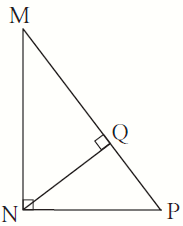

To find:
NQ
In ![]() ,
,
![]() ………….(Pythagoras
theorem)
………….(Pythagoras
theorem)
![]() ………………(M-Q-P)
………………(M-Q-P)
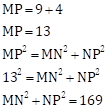

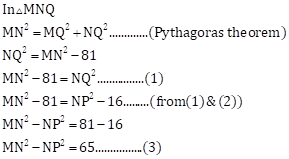
Adding (1) and (2)
![]()
From (3) and (4),
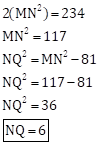
Solution 3
Given:
∠ QPR = 90°,
seg PM ⊥ seg QR
Q-M-R,
PM = 10, QM = 8
To find:
QR
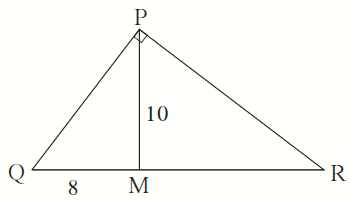
![]()
Let MR be x units
![]() ………….(1)
………….(1)
In ![]() ,
,
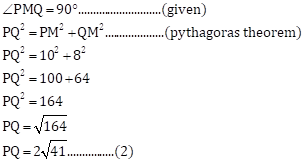
In ![]() ,
,

In ![]() ,
,
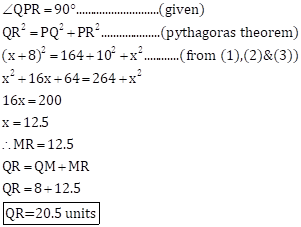
Solution 4
Given:
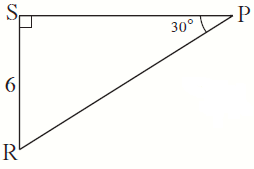
To find:
RP and PS
In ![]() ,
,

Now PR is
hypotenuse ![]()

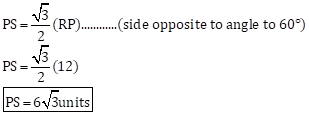
Solution 5
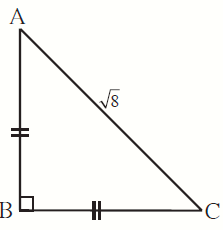

Solution 6
Given:
![]() is a square
is a square
![]()
Diagonal of
square, ![]()
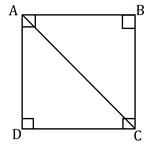
To find:
Side and perimeter of square
In ![]() ,
,

![]() Side of a square
Side of a square
![]()
![]() Perimeter of
square
Perimeter of
square

Solution 7
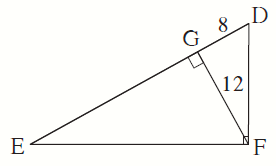
Given:
∠DFE = 90°
FG ⊥ ED
GD = 8
FG = 12
To find:
EG
Let EG=x
First, we have to find FD and EF
As in ![]() ,
,

To find EG we have to find FD
In ![]() ,
,
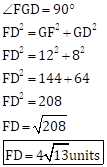
To find EF
In ![]() ,
,
![]()
EG be x
Then ![]()

In ![]() ,
,
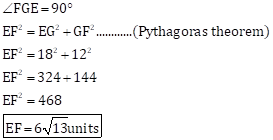
Solution 8
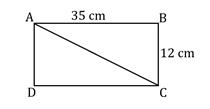
Given:
![]() is a rectangle
is a rectangle
l(AB) = 35 cm
l(BC) = 12 cm
To find:
Diagonal AC
In ![]() ,
,
![]() …..(each angle of
rectangle is
…..(each angle of
rectangle is ![]() )
)
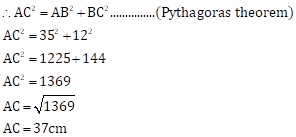
Diagonal of the rectangle is 37cm.
Solution 9

Given:
∠ PRQ = 90°
M is the midpoint of QR
To prove that:
PQ2 = 4PM2 - 3PR2
Let ![]()
![]() …….(Given that M
is the midpoint of QR)
…….(Given that M
is the midpoint of QR)
In ![]() ,
,

In ![]() ,
,

From (1) and (2),

Solution 10
Given:
Walls of two buildings on either side of a street
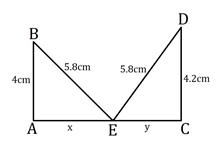
AB is the distance of first wall where top of ladder touches window of first building
AB=4m
DC is the perpendicular distance of wall where top of ladder touches window of second building
DC=4.2cm
Length of ladder= 5.8cm
Let the bottom of ladder touch the road at point E
![]() length of ladder
length of ladder
Let AE distance between wall of first building and bottom (foot) of ladder be x
Let EC distance between wall of second building and (foot) of ladder be y
![]() As distance
between walls of two buildings is width of street
As distance
between walls of two buildings is width of street
Width of street ![]()
In ![]() ,
,
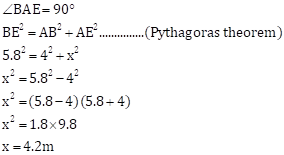
In ![]() ,
,
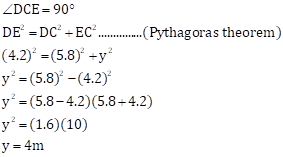
Now,

The width of the road is 8.2m.
Pythagoras Theorem Exercise 2.2
Solution 1
Given:
Point S is the midpoint of the side QR
PQ = 11
PR = 17
PS =13
To find:
QR
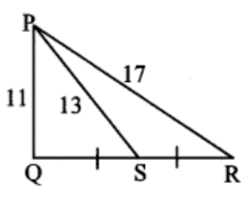
In![]() ,
,
PS is the median…………. (QS=SR)

Solution 2
Given:
In ∆ ABC,
AB = 10, AC = 7, BC = 9
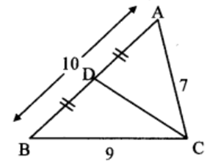
To find:
The length of the median drawn from point C to side AB
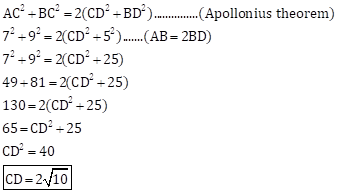
Solution 3
Given:
seg PS is the median of ∆ PQR
PT ⊥ QR
To prove that:

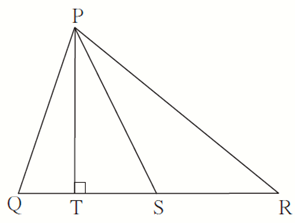
In ![]() , where
, where ![]() is an
obtuse angle
is an
obtuse angle

In![]() ,
, ![]() is
acute angle
is
acute angle

Hence proved.
Solution 4
Given:
Point M is the midpoint of side BC
AB2 + AC2 = 290 cm2,
AM = 8 cm
To find:
BC
In ![]() ,
,

![]()
Solution 5
Given:
Point T is in the interior of the rectangle PQRS
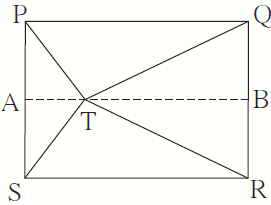
To prove that:
TS2 + TQ2 = TP2 + TR2
Construction:
Draw seg AB || side SR and A-T-B
As the angles of
a rectangle are ![]()
![]()
Therefore, ABRS is a rectangle
![]()
In ΔPTS,
![]()
Similarly, in ΔQTR
![]()
Subtracting (1) and (2),

Hence proved.
Pythagoras Theorem Exercise Problem Set 2
Solution 1(i)
To find the Pythagorean triplet we will substitute the values in the equation
![]()
Consider option (A),

Consider option (B),

Consider option (C),

Consider option (D),

Answer: (B) (3, 4, 5)
Solution 1(ii)
Given that, the sum of the squares of the sides making right angle is 169.
We have to find the length of the hypotenuse.
According the Pythagoras theorem, the sum of the squares of the sides making right angle is equal to the square of the hypotenuse.
Let the sides be a, b and let the hypotenuse be c

Answer: (B) 13
Solution 1(iii)
To find the date which is a Pythagorean triplet we will substitute the values in the equation
![]()
Consider option (A),

Consider option (B),

Consider option (C),

Consider option (D),

Answer: (A) 15/08/17
Solution 1(iv)
If a, b, c are
sides of a triangle and a2 + b2 = c2, the type of triangle is an right angled
triangle. ![]()
Answer: (C) Right angled triangle
Solution 1(v)
Given:
Diagonal![]()
We have to find the perimeter
The diagonal of a square is the hypotenuse of two adjacent sides of the square
As all the angles of the square are right angles
Let the side of the square be 'a'

Answer: (A) 10cm
Solution 1(vi)
Given that altitude on the hypotenuse of a right-angled triangle divides it in two parts of lengths 4 cm and 9 cm
We have to find the length of the altitude
Let the length of the altitude be 'x'
x2 = 4 x 9 ……… (theorem of geometric mean)
x2 = 36
x = 6
Answer: (C) 6cm
Solution 1(vii)
Given:
Height, a=24cm
Base, b=18cm
We have to find the length of the hypotenuse (c)

Answer: (B) 30cm
Solution 1(viii)
Given:
In ∆ ABC, AB = 6 ![]() cm,
AC = 12 cm, BC = 6 cm
cm,
AC = 12 cm, BC = 6 cm
To find:
The measure of ∠ A

Therefore, using
the ![]() theorem
theorem
![]()
Answer: (A) ![]()
Solution 2(i)
We have to find the height of an equilateral triangle of side 2a
In an equilateral triangle the height is also the median
Consider the triangle ABC and the height BD
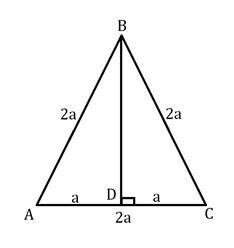
In triangle ADC,
AB is the hypotenuse
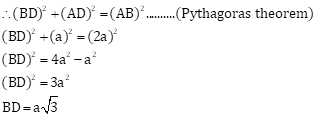
The hypotenuse is
![]() units.
units.
Solution 2(ii)
We have to determine if sides 7 cm, 24 cm, 25 cm form a right angled triangle
We will use the Pythagoras formula to determine
Let
![]()
Therefore,

Hence from the above proof, the sides 7 cm, 24 cm, 25 cm do form a right angled triangle.
Solution 2(iii)
Given the length of the sides of a rectangle
11cm and 60cm
To find:
The length a diagonal

Consider the above figure of rectangle PQRS with diagonal PR
In ![]() ,
,
![]()
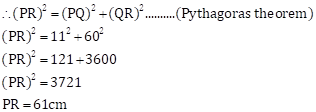
The length a diagonal is 61cm.
Solution 2(iv)
Given the sides of a right-angled triangle;
a=9cm and b=12cm
We have to find the hypotenuse (c)
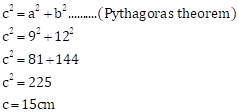
The length of the hypotenuse is 15cm.
Solution 2(v)
Given the side of an isosceles right-angled triangle is x
We have to find hypotenuse (h)

The hypotenuse of
the isosceles right-angles triangle is ![]() .
.
Solution 2(vi)
Given:
In ∆ PQR; PQ = ![]() ,
QR =
,
QR =![]() , PR =
, PR =![]()
We have to
determine if is ∆ PQR a right-angled triangle and if yes which angle is ![]()
We will use the Pythagoras theorem
![]()
Let
![]()

As,
LHS=RHS
The triangle PQR is a right-angled triangle
As, PQ is the
longest side, the angle R will be ![]() .
.
Yes, ∆ PQR a
right-angled triangle with ![]() as
as ![]() .
.
Solution 3
Given:
In ∆ RST, ∠ S = 90°, ∠ T = 30°, RT = 12 cm
To find:
RS and ST

As,

Using the ![]() property,
property,

Therefore in ![]() ,
,

Solution 4
Given:
Length of the rectangle, l=16cm
Area of the
rectangle, ![]()
To find:
The diagonal of the rectangle (d)
As we know,
Area of rectangle is the product of length and breadth (b),

Diagonal of a rectangle is the hypotenuse of the two adjacent sides (length and breadth) of a rectangle

The diagonal of the rectangle is 20cm.
Solution 5
Given:
Height of
equilateral triangle, ![]()
To find:
Length of the side and perimeter
Let the sides of the equilateral triangle be 2x
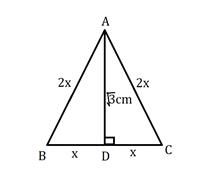
![]()
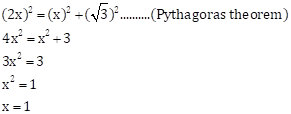
Therefore, of the side of the equilateral triangle is
![]()
Perimeter of the equilateral triangle,

The length of the side is 2cm and the perimeter is 6cm.
Solution 6
Given:
In ∆ ABC seg AP is a median
BC = 18,
AB2 + AC2 = 260
To find:
AP
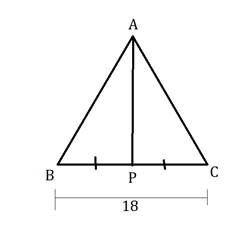
Using the Apollonius theorem,

Solution 7
Given:
∆ ABC is an equilateral triangle
PC = ![]() BC
BC
AB = 6 cm
To find:
AP
Construction:
AD perpendicular to BC
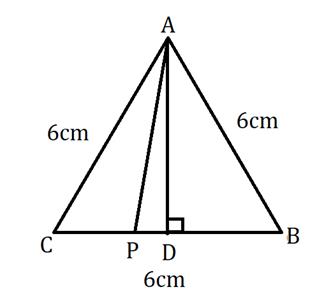

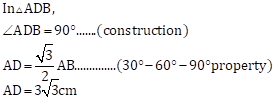

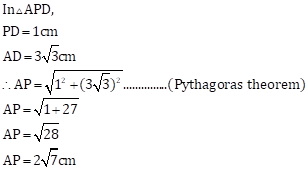
Solution 8
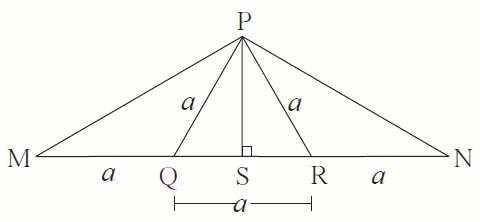
To prove that
PM = PN = ![]() ×
a
×
a
Proof:
![]() is
equilateral triangle with side=a
is
equilateral triangle with side=a
Therefore,


Similarly,

PM = PN = ![]() ×
a
×
a
Hence proved.
Solution 9
Given:
![]()
Diagonals AC and BD

To prove that:
The sum of the squares of the diagonals of a parallelogram is equal to the sum of the squares of its sides
i.e., ![]()
Proof:
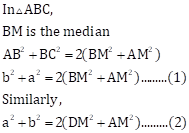
Adding (1) and (2),
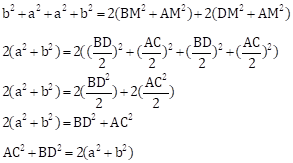
Hence proved that, the sum of the squares of the diagonals of a parallelogram is equal to the sum of the squares of its sides.
Solution 10
Given:
Pranali and Prasad started walking to the East and to the North respectively
Their speeds are same
After 2 hours
distance between them was 15 ![]() km
km
To find:
The value of speed
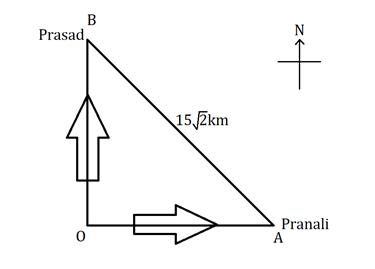
As, their speeds
were equal they travelled equal distances in the 2 hours i.e., ![]()
Consider the
above diagram, distance between Pranali and Prasad is the hypotenuse i.e., ![]()
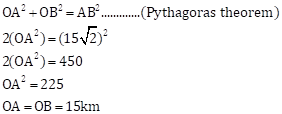
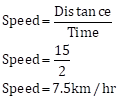
The speed of both
Pranali and Prasad is ![]() .
.
Solution 11
Given:
In ∆ ABC, ∠ BAC = 90°, seg BL and seg CM are medians of ∆ ABC
To prove that:
![]()
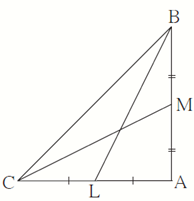
Proof:
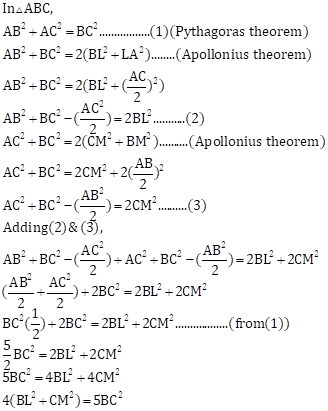
Hence proved.
Solution 12
Given:
Sum of the squares of adjacent sides of a parallelogram is 130 sq.cm
i.e., ![]()
One of the diagonal measures 14cm
To find:
Length of the other diagonal
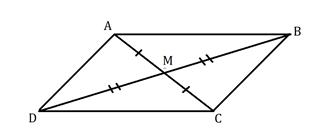
Diagonals of a parallelogram bisect each other
Therefore, M is the mid points of diagonals AC and BD
Let BD=14cm
![]()
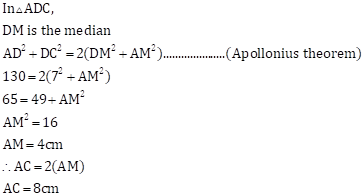
Therefore, the length of the other diagonal is 8cm.
Solution 13
Given:
In ∆ ABC, seg AD ⊥ seg BC DB = 3CD
To prove that:
2AB2 = 2AC2 + BC2
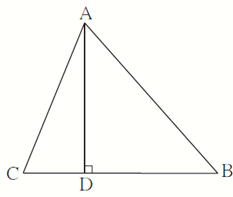
Proof:
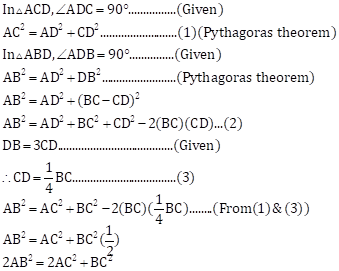
Hence proved.
Solution 14
Given:
The length of the congruent sides of isosceles triangle is 13 cm
and its base is 10 cm
To find:
The distance between opposite vertex and the base of centroid

Consider the above isosceles triangle, we have to find AG, where G is the centroid.
AB=AC=13cm
BC=10cm
Using the Apollonius theorem,
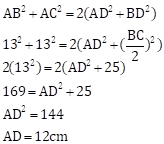
As we know, the centroid divides the median in the ratio 2:1

The distance between opposite vertex and the base of centroid is 8cm.
Solution 15
Given:
seg AB || seg DC
seg BD ⊥ seg AD
seg AC ⊥ seg BC
AD = 15, BC = 15 and AB = 25
To find:
A (▭ ABCD)
Construction:
DP![]() AB
AB
CQ![]() AB
AB
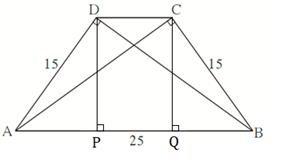
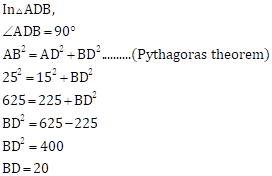
As,

Therefore,
![]()
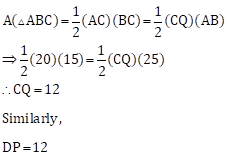

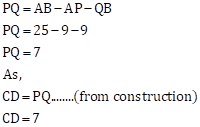
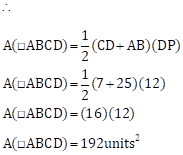
Solution 16
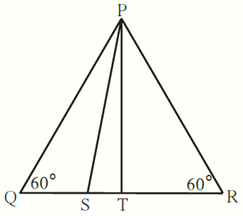
Given:
∆ PQR is an equilateral triangle
![]()
To prove that:
![]()
Construction:
PT, where T is the midpoint of QR
Proof:

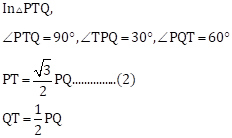
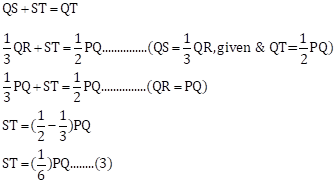

Hence proved.
Solution 17
Given:
PQ = 40, PR = 42 and PM = 29
Seg PM is a median of ∆ PQR
To find:
QR
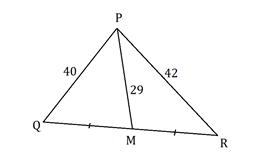
![]()
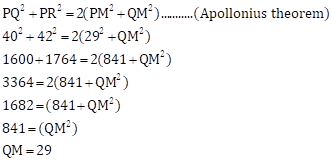

Solution 18
Given:
AB = 22,
AC = 34,
BC = 24
Seg AM is a median of ∆ ABC
To find:
AM




